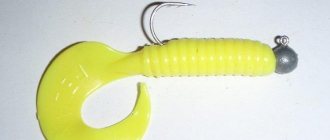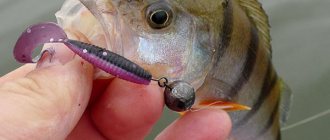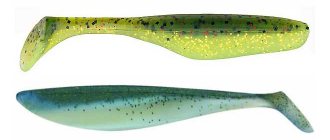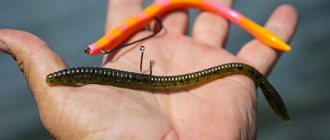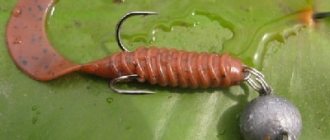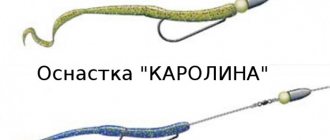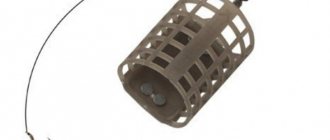general characteristics
Currently, floating silicone baits are widely popular among spinning fishermen. They have proven themselves excellent in catching predatory fish species and have won well-deserved recognition from both experienced and novice fishermen. With the correct selection of such baits, a rich catch is always guaranteed. But how to understand all the available variety of these very, very popular products?
To do this, first of all you need to know what this type of gear is. This product is an imitation of various living organisms (worms, larvae, fry, frogs, etc.) that make up the food supply of aquatic predators. To decide on the choice of bait, you should consider their classification by shape, size and color.
Types of silicone baits for spinning rods
Silicone bait used in fishing is an excellent catcher of predatory wayward fish. Fishing will always be successful if you choose the right silicone companion, but how to understand the variety of soft baits presented? Colors, shapes, material options, functional features can lead a novice spinning angler into complete confusion... A series of articles devoted to the types of silicone baits, their features and structure, methods of use and fishing tactics, mounting options and other important points when fishing with a jig will dispel everything doubts and will help you accurately select the desired bait option and properly equip the spinning rod.
Bait shapes
There are different types of bait types presented. The predator reacts actively to floating silicone. But you need to choose a product that best matches the type of fish food supply. There are the following types of such baits:
- Twisters. They consist of a cylindrical body and a flat, soft, sickle-shaped tail. Sometimes there are several of them. The surface of the body is often ribbed or wavy. From a distance, the twister resembles a larva. It is used for active play, thanks to which the tail vibrates, attracting a predator.
- Vibrating tails. They have a specific flat tail, always located perpendicular to the body of the bait. In appearance, vibrotails look like fry. Different models have different tail angles, which adds additional variety to the game.
- Silicone worms. They imitate real worms very realistically. They are usually a passive bait, but there are models with a soft tail that actively play with various types of wiring.
- Slugs. Passive bait, not intended for wiring. Copies a small flat fish or a large worm with its tail torn off.
- Frogs. Those made with legs belong to the active type of bait. Those with soft rubber fringes instead of paws are classified as passive. The fringe sways with the movement of water and attracts the attention of a predator.
- Creatures. They imitate the shape of a wide variety of underwater inhabitants, most often crustaceans.
You need to have several types of bait with you. You may have to experiment to get the predator to pay attention to the item on the hook.
What does active and passive silicone mean?
Active baits are those that have a pronounced game of their own when they are retrieved. Such artificial baits can be used both in still (calm) water and in currents, and there are no rules for conducting the retrieve. With active silicone, it will be easier for a beginning spinner to get used to jig fishing.
Passive baits are those that do not have any activity (play) when they are immersed in water. In order to provoke the bait, you need to competently approach the issue of performing postings in various fishing conditions. Passive silicone is typically used in standing water.
Read about the variety of techniques and wiring, the rules for their implementation and other important points here
The disadvantage of passive baits is that the effectiveness of fishing with them directly depends on the abilities and dexterity of the spinning angler.
Educational video about passive silicone baits in a video from the Shcherbakov brothers
How to visually distinguish passive baits from active ones? Thus, passive baits have an external resemblance to their living prototype, while, like active ones, they have interesting tails, due to which their game occurs.
Classification by size
The size of imported floating silicone baits is indicated in inches, domestic ones - in millimeters. It should be remembered that 1 inch corresponds to 25.4 mm. Depending on the purpose and method of fishing, there are the following size categories:
- For microjig. From 0.5 to one and a half inches.
- For fishing from the shore. From 2.5 to 9 inches. The size of the bait in this case depends on the fishing conditions and the casting distance.
- For trolling. These are the largest imitations, up to 12 inches long.
Typically, the dimensions of the silicone depend on the size of the intended production. However, fishing with microjig very often pleases with very large specimens. For a good result, it is important to choose the correct sizes of hooks and weights in accordance with the dimensions of the bait.
Color solution
There are several dozen colors of silicone baits. By using different colors and shapes, you can choose the most catchy option. Experienced fishermen recommend choosing bait in natural colors in autumn and early spring - gray, brown, green. Small bright inclusions are allowed.
In late spring and summer, preference should be given to silicones of bright colors. In addition, it has been noted that in muddy water it is preferable to use conspicuous baits, and in a clear body of water with good visibility - discreet ones.
Material
For the manufacture of artificial baits, various materials are used, on which the performance characteristics of the product and the scope of its application depend. Usually, based on the type of material used, they are distinguished:
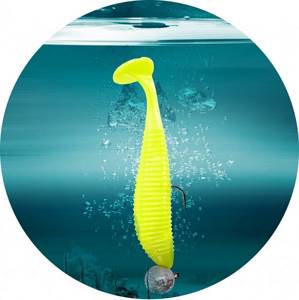
- classic inedible baits;
- baits made of edible silicone;
- floating silicone baits;
- artificial maggot, worm, bloodworm.
Over the past few years, floating varieties of baits have achieved well-deserved recognition among fishermen. And this is not surprising - the predator reacts very actively to such silicone. Currently, these baits are produced in both edible and inedible versions.
Advantages
Possessing maximum similarity to the food items of predators, a floating silicone bait invariably attracts their attention. It has proven itself well when catching sluggish fish, as it remains afloat during long pauses during slow retrieves.
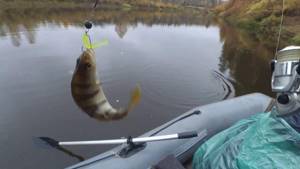
In addition, when the movement stops, such a bait is located perpendicular to the bottom, and in this position it is much easier for a predator to attack it.
According to reviews, such products show excellent results when using the “drop shot” fishing technique. The bait is indispensable in reservoirs with strong currents and in places with an overgrown bottom, since it does not sink down, does not cling to algae and is able to play in water currents.
Crawler - winged wobbler
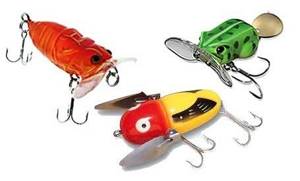
The crawler is another exotic topwater, not yet familiar to many spinning anglers. It got its name for its special manner of movement, similar to the crawl style of swimming.
The question is, how did a crawler, which has as many as two blades, fall into the category of bladeless baits?
The blades located across the body of the crawler perform a completely different function; they participate in the process of forming the manner of play of the bait and its sound accompaniment - gurgling.
There are two main types of crawlers: with folding doors - wings on the sides of the body and with a blade in the bow .
The first type of crawler, in its behavior and appearance, imitates winged insects: bees, beetles, dragonflies, butterflies, flies, etc., that have fallen into the water and are trying in every possible way to get out of it. Therefore, the folded plates located on the body of these wobblers are called wings.
Swimmers in the following design, with a transverse plate in the bow, more like a bulldozer blade than a wide open mouth of an animal, copy other food objects without flying abilities: mice, frogs, tadpoles, caterpillars, and juvenile fish.
Winged crawlers have good flight qualities due to their shape and special design, which allows you to fold the flaps of the bait before casting it and independently, under the influence of water resistance, straighten them during retrieving. Bulldozer crawlers have better maneuverability in wetlands. Winged baits are inferior to them in this quality, due to the lateral location of the valves and their large span; vegetation sticks to them, making it difficult for the wobbler to move.
Unlike the glider, both types of BV are equipped with open hooks - tees, which prevent their use in wetlands and orient the crawlers towards bodies of water with moderate vegetation.
Wiring for them does not require any special skill; with a uniform rotation of the reel, with a rigidly fixed spinning rod, the crawler “rows” at one hundred percent, like an avid swimmer, drives a wave in front of itself and provides a characteristic gurgling sound, doing everything that it is supposed to do.
The wiring speed, largely depends on the bait model and for most crawlers, should not be slow, but in some cases, for some units, it may be appropriate.
Lucky John lures
Among the huge variety of products for catching predators, offered by both domestic and foreign manufacturers, it is worth noting Lucky John floating silicone baits. They are very durable, catchy and are, perhaps, one of the best offers in terms of price and quality ratio.
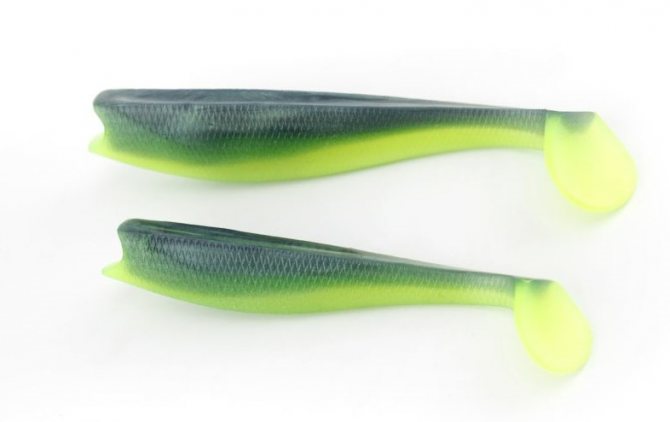
Lucky John Joco Shaker is a classic vibrating tail in shape. The product in the middle part is almost entirely covered with transverse ribbing, shallow but frequent. This texture, firstly, increases the resemblance to a small fish, and secondly, it increases the surface area emitting an attractant - an odorous substance that attracts a predator.
Thanks to the shape of the tail, the bait makes active high-frequency movements in the water, playing well on a uniform retrieve. It thereby attracts the object of fishing. Vibrating tails are produced in three modifications:
- 2.5 inches for catching medium-sized predators. Used in cases where it is necessary to adjust the size of the bait due to the reluctance of fish to attack a larger bait.
- 3.5 inches. Universal size. Used for jig fishing for pike, pike perch or large perch.
- 4.5 inches. Designed for catching large predatory fish, as well as large catfish with a jig in pits.
When choosing floating silicone baits for pike perch, perch, trout or other types of fish, the products of the presented company are considered first.
Choosing the color of the silicone bait
It can take a lot of time and nerves to choose the color and shape of a catchable bait. I’ll try to reduce your time spent searching for the right color of bait for catching pike. Here, as in the selection of a wobbler, we also apply color selection depending on weather conditions and water transparency. The less transparent the water, the brighter the bait should be placed. With natural colors and clear water, it is better to use gray, yellow-light green or two-color baits, also do not forget about the size of the bait used to catch the predator. As the size increases, the pike may mistake the bait not as prey, but as a competitor laying claim to its territory and try to attack it.
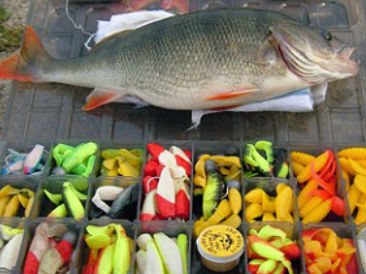
But not all silicone baits are suitable for fishing from the bottom; now there are many floating baits made of silicone. If you take a silicone bait and just throw it into the water, it will surely sink to the bottom. In order to give the bait positive buoyancy, the composition includes foam and many other things that allow it not to sink or sink slowly.
Thanks to modern developments, silicone can be used to catch not only predators, but also quite noble fish such as crucian carp, chub, carp, silver carp, and this is not the whole list. Noble fish are also not averse to trying silicone delicacies. Here's an article on how to catch crucian carp and if you use silicone as bait you can get good results. The article is here.
Floating silicone
Floating silicone allows you to fish in heavily overgrown reservoirs. To do this, just find a small window and lower the floating bait there. Made from special floating materials and being on the surface of the water, the bait skillfully imitates a bug or fly that has fallen into the water, and with the slightest twitching of the rod it can quite plausibly flounder with its legs. For a predator, you can also choose bait in the form of a feeding fry on the surface of the water, which also provokes the predator into action.
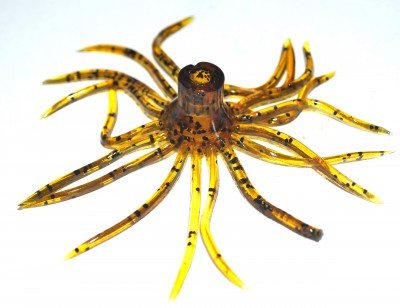
BUT this is not all the advantages of silicone baits. Today, thanks to many years of testing by world companies in the field of bait manufacturing, you can also easily choose a bait that can move in the water flow like a wounded or sick fish. In the struggle for the sales market, the largest manufacturers are ready to present silicone baits that are completely similar to natural live bait, not only in body shape, but also in eye color, smell and taste. Here are a few companies that provide a wide range of excellent quality baits: companies such as S amba, Lucky John, Reins, Keitech, Shaker, RELAX.

That's all for today, our acquaintance with silicone baits is complete for today. Write in the comments whether you liked this article, follow the links in the text, read previous articles on baits of various types. Leave comments on other articles and also write what you would like to know more about.
I wish everyone good weather and no tail, no scales!!!
DIY bait
If you don’t really want to spend money on a purchased bait, you can make it yourself. It's a fascinating process. How to make a floating silicone bait with your own hands? Yes, very simple. To do this, you will need a floating material, such as polystyrene foam. It is better than the usual polystyrene foam, due to its greater density and uniformity of structure.
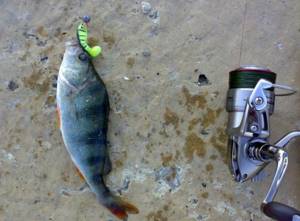
A piece of suitable size is cut from it. Then an incision is made on the back of the bait with a sharp knife or blade. A prepared piece of polystyrene foam (or other floating material) is inserted into it. The cut is sealed with a soldering iron.
The second method of making bait is used specifically for twisters. A small longitudinal hole is drilled in it from the head. The internal space is filled with construction foam. After it dries for three to five hours, the bait is ready.
Equipment
When installing a silicone bait, it is very important to select the correct weight of the hooks so that they do not impair its buoyancy. Therefore, such baits are equipped with special heads. They improve the game when retrieved.
Floating heads for silicone baits made of ultra-light materials can be purchased at the store. But more often, fishing enthusiasts use homemade heads made of cork or foam. It is done very simply.
Select the hook of the desired size. A cylinder is cut out of cork or foam plastic. A lead weight is attached to its lower part. The heavier it is, the larger the plug should be taken. To improve the performance of the bait, the front part of the cylinder is made beveled. It is good if the hook fits onto the back loop of the cork.
Where are they used?
With the help of floating rubber you can catch almost any predatory fish in our reservoirs. So, for example, it makes sense to use bait for pike perch in cases where it hunts on the bottom. When the bait falls, it becomes vertical, allowing the predator to see it better and attack.

The use of floating silicone when fishing with a retractable leash also pays off. Long pauses, during which the bait slowly floats up, can make an inactive pike perch want to take a bite. The best baits for catching this fish are twisters and vibrotails.
Floating silicone baits are also good for trout fishing with ultralight. Among all types of baits, this fish prefers artificial worms. However, successful trout fishing depends not so much on the bait, but on the way in which this bait is offered to it and in what layers of water the fish are currently located.
Having considered the features of floating silicone baits, you can choose the best option for specific fishing conditions.
How to catch a floating rig for carp
Sometimes the carp does not want to sink to the bottom and take the bait from the bottom. There can be many reasons for this fish behavior. For example, the temperature stratification of water in calm, warm weather, when the fish basks in a warm layer. Or the presence of floating food, including that abandoned by fishermen, which the carp collects from the surface.
At the same time, anglers are mainly trying to catch carp from the bottom. To do this, use the appropriate equipment, perhaps with a slight ascent of the nozzles. If there are no bites, then the reason is often cited as an unsuccessful choice of place for unsuitable baits and bait that need to be changed.
In fact, there may be plenty of carp in the fishing area, they just move on top, the only question is the correct presentation of the bait. It must be applied to the horizon where the fish is located. Floating rigs, and the entire method of fishing with floating baits, are also called zig-rigs.
How to fish with a floating bait
When fishing for carp, if there are no bites from the bottom for a long time, at least one rod should be equipped with a zig-rig and fish different horizons in the baited area. If the carp simply does not sink to the bottom, then bites on the floating bait will not take long to arrive.
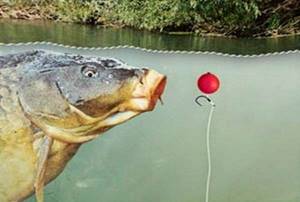
How to ensure that the bait floats to the upper layers of the water? How to regulate the amount of sub-ascent?
It is possible to use a floating attachment on a long leash. But this is not the most practical solution. It is advisable to use a float controller. It can be made from a sbirulino float or purchased ready-made at a fishing store.
Zig-rig equipment diagram
The diagram of such a modified zig-rig with an underwater float is shown in the figure.
The float is attached to a fishing line with a leash. The fishing line runs inside the float tube, about 20 cm long. A bead is glued to the lower end of the tube, which does not fit into the ring on the sinker when casting the tackle. The ring with which the sinker is supplied can be made from the tulip of the fishing rod.
As a result, with such equipment it is possible to regulate the amount of sub-floating of the nozzle after casting.
You can raise the nozzle to the surface of the water and then lower it to the bottom, holding it every half meter for 15 minutes. Or vice versa, start fishing from the bottom, gradually lifting the bait up (releasing the line).
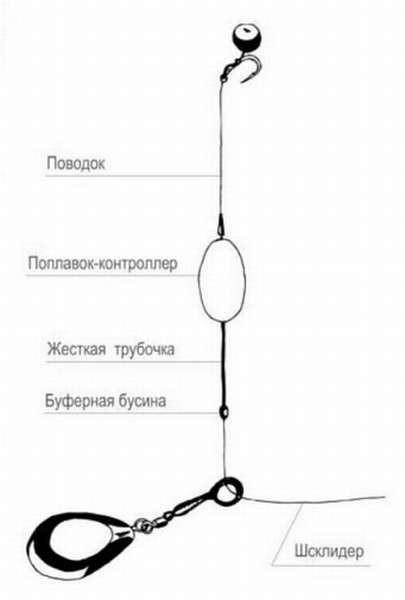
It is not recommended to keep more than two of these baits in the fishing area as they can get confused, especially when biting. In addition, when fishing with a zig-rig, you should always expect a carp to bite from the bottom, and place at least a couple of equipment there, since the floating bait will gradually end up on the bottom anyway.
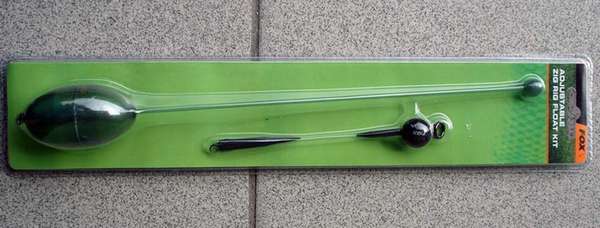
How to position the nozzle
A floating bait for this type of fishing must be made from two different-colored components. It is impossible to predict how the fish will be positioned, higher or lower from the bait. Therefore, the lower component should be dark in color to stand out against the light sky. And the top one should be light-bright, noticeable against the background of the bottom. It is best to use special attachments for zig-rigs and foam.
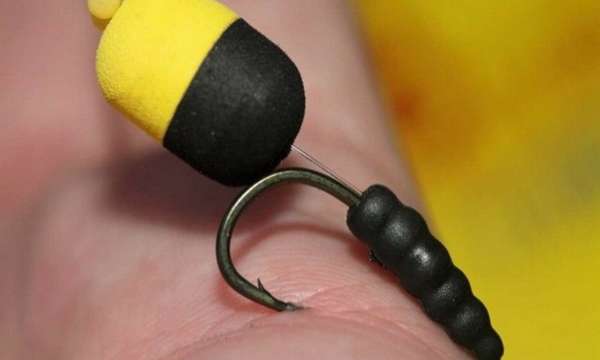
The color visibility of the bait in the feeding cloud is also an important component of success. Practice shows that you need to use the most contrasting colors: black below, yellow above. It is also useful to color the foam with fluorodip, which gives an additional greenish glow.
Principles of feeding when using zig-rig
The success of carp fishing using a zig-rig will entirely depend on proper feeding. The principle is the same as when catching bleak, creating a cloudy column of bait in the water, consisting of particles of different buoyancy. Some of them will quickly sink to the bottom, others will float on the surface for a long time, and others will slowly settle.
To maintain a floating bait field for carp, you need to throw 2-3 rockets of bait every 20-30 minutes. It happens that the fish is too afraid of the falling bait and moves away from the point. Then the feeding period should be increased to an hour.
If the bait is outside the feeding field, then the bite can only happen by chance. The main thing is accuracy, otherwise there will be no success. It is necessary to clip the line of the spod rod, and also cast along the selected landmark.

How to make bait for floating baits
When creating a complementary food that is dusty and attractive to carp, certain difficulties may arise, since it is desirable to use many components.
It is better to use liquid bait - viscous carp soup. The simplest, but not the most effective, is to use corn dirt - ground corn with dust from these grains. As a result of its use, a cloudy cloud will already be created in the water. This is the starting point for further experiments.
The mud must be moistened with various attractants, amino complexes, attractant, fish oil, hemp oil, etc. Then an extensive odor field is formed in the water. The same additives can be used for more complex baits.
You can also try using fluoroliquids, which color the water greenish, which is very attractive to grass carp.
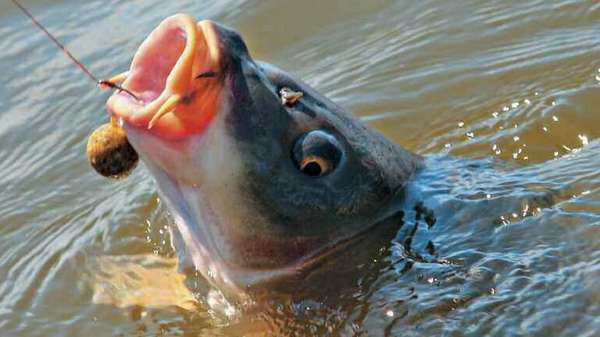
A more complex composition based on fine bottom bait or spod-mix (mixture for a rocket). For example, the following could be added to it:
- crushed, ground, floating and sinking
- boilies, soaked and partially mashed grains,
- wheat bran,
- cereals,
- crushed popcorn,
- powdered milk,
- ground gingerbread,
- floating food for koi carp,
- dried daphnia,
and other components with different buoyancy, which are used in carp fishing or may be attractive to it.
Using the above techniques will ensure that the area is examined for the presence of carp in the upper layers and will help ensure that it bites. In any case, on any carp fishing you need to have a ready-to-use zig-rig in stock, at least with a simplified floating bait. If it doesn’t bite from the bottom, then examining the water column using the zig-rig method is the usual effective solution.
